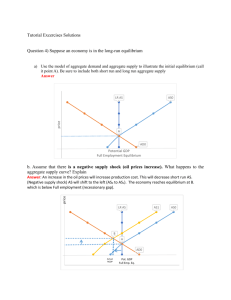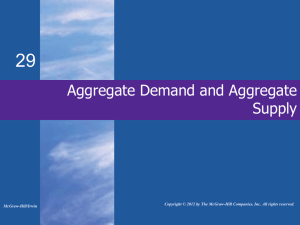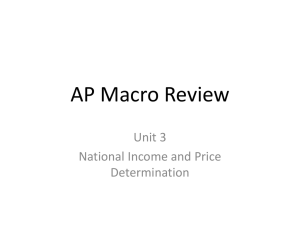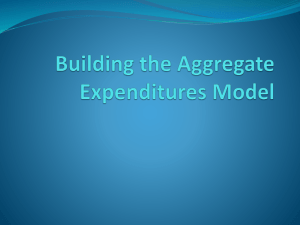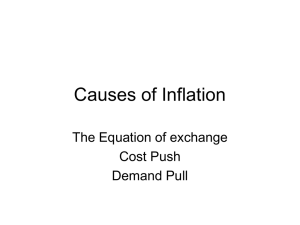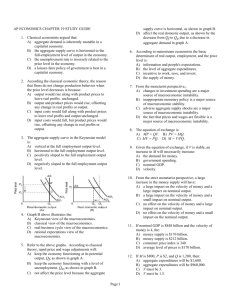10 AS AD
advertisement
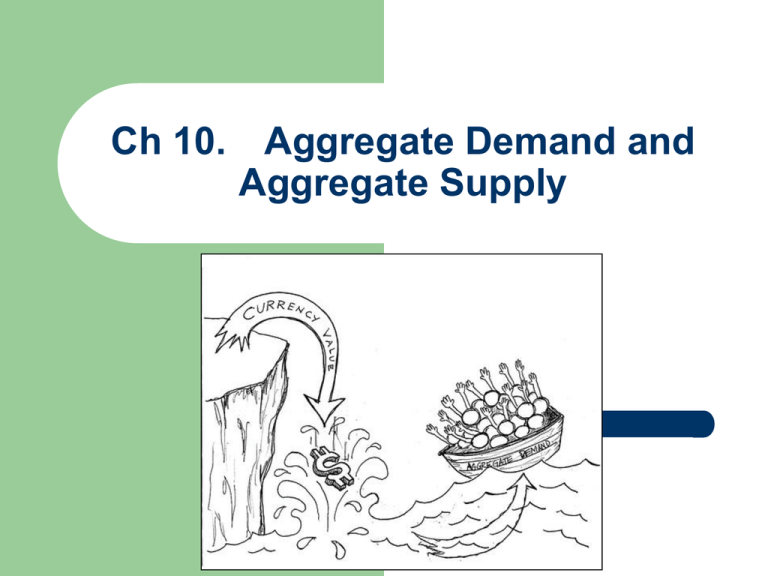
Ch 10. Aggregate Demand and Aggregate Supply Aggregate Demand-Aggregate Supply model (AD-AS model). Enables us to analyze changes in real GDP and the price level simultaneously. Provides insights on inflation, recession, unemployment, and economic growth. A. Aggregate Demand – schedule or graph that shows the amounts of real output that buyers collectively desire to purchase at each possible price level. -- Aggregate Demand = all demand together. AS D 0 Real domestic output, GDP The aggregate demand curve: downsloping indicates an inverse (negative) relationship between the price level and the amount of real output purchased. Also downsloping due to real wealth balance effect (how we feel about market), foreign trade effect (P = sales), and interest rate effect. Change in Aggregate Demand A change in the determinants of AD will SHIFT the AD curve. Right shift from AD1 to AD2 shows an increase in AD. Left shift from AD1 to AD3 shows a decrease. AD3 Changes in Aggregate Demand Changes in Aggregate Demand Curve Price Level Increase in Aggregate Demand Decrease in Aggregate Demand AD2 AD1 AD3 Real Domestic Output, GDP B. Aggregate Supply – schedule or graph showing the level of real output that firms will produce at each possible price level. -- AS = supply of everything in our economy (U.S. GDP). -- Sticky Wages = labor contracts stuck at a certain level. Aggregate Supply 2003 1. Aggregate Supply in the LongRun (ASLR) – vertical at fullemployment level of real GDP (Qf). -- Long run – In Microeconomics, a period of time long enough to enable producers of a product to change the quantities of all the resources they employ. Price = real output. Price = real output. Aggregate Supply (short-run) Price Level PL Qf Real domestic output, GDP 2. Q Upsloping AS curve indicates a direct (or positive) relationship between the price level and the amount of real output that Firms will offer for sale. AS in the short-run (ASSR) -- Short-run – In Microeconomics, a period in time in which producers are able to change the quantities of some, but not all of the resources they employ. -- If price-level rises, output increases, and profits increase because wages are fixed. -- Wages are fixed and sticky because of contracts, unawareness. Changes in Aggregate Supply Understanding Productivity Productivity Total Output Total Inputs = = Total Output Total Inputs 10 5 = 2 3. Determinants of AS Which is a decrease and which is an increase? -- Aka aggregate supply shifters. -- Change in Aggregate Supply Changes in Aggregate Supply Changes in Aggregate Supply Curve AS3 AS1 Decrease in Aggregate Supply Price Level AS2 Increase in Aggregate Supply Real Domestic Output, GDP (a) shows decreases & increases in price level. (b) shows decreases & increases in aggregate supply. C. Equilibrium – intersection of the AS & AD curves. -- Equilibrium price level and equilibrium real output = intersection. -- AS & AD jointly establish the price level and level of real GDP. AD/AS Model PL AS (Factors of Production) shifting Pe AD (C + I + G + Xn) shifts 0 Qe Q AS: Factors of Productions (land, labor, capital, & entrepreneurial); can also include business tax & business regulation. AD: Consumer expenditures, bus. investment, gov’t expend. & net exports. The “I” in AD is business investment on demand side because the market demands payment. Equilibrium and Changes in Equilibrium Tabular View… Real Output Demanded (Billions) Price Level (Index Number) Real Output Supplied (Billions) $506 108 $513 508 104 512 510 100 510 512 96 507 514 92 502 Equilibrium Price Level and Equilibrium Price Level Equilibrium and Changes in Equilibrium Price Level AS Equilibrium 100 92 a b AD 502 510 514 Real Domestic Output, GDP (Billions of Dollars) In the short-run Prices Real GDP Qf D. Q1 Increases in AD: Demand-Pull Inflation – price level is being pulled up by increase in AD. Equilibrium and Changes in Equilibrium Increase in Aggregate Demand Price Level AS Demand-Pull Inflation P2 P1 AD1 AD Qf Q1 Q2 Real Domestic Output, GDP P1 E. Decrease in AD: recession & cyclical unemployment. a b Q1 Qf -- AS = Factors of Productions (land, labor, capital, & entrepreneurial); can also include business tax & business regulation. -- AD = C + I + G + Xn. -- A decrease in aggregate demand that causes a recession. -- A negative GDP gap of Q1 minus Qf results. Equilibrium and Changes in Equilibrium Decrease in Aggregate Demand Price Level AS b P1 a c P2 Creates a Recession AD1 AD2 Q1 Q 2 Qf Real Domestic Output, GDP “Cut in gov’t spending” P2 Q2 -- AD = C + I + G + Xn -- AS = Factors of Production Q Q “During a Recession” PL LRAS AS Pe Qe Unem AD2 AD1 O Q Price Level AS2 AS1 P2 b a P1 Q1 Qf Q Real domestic output, GDP F.Decrease in AS: Cost-push Inflation -- A decrease in AS that causes cost-push inflation. Cost-Push Inflation: Supply shock causes increase in price level, Govt has a policy dilemma, either higher price level or lower economic output. Equilibrium and Changes in Equilibrium Decrease in Aggregate Supply Price Level AS1 Cost-Push Inflation P2 P1 AS b a AD Q1 Qf Real Domestic Output, GDP Increase in productivity, but not in wages (sticky wages?!?) PL AS1 Q PL Unem AS2 AD O Q “Decrease in Int’l value of Dollar” PL AS PL1 PL2 PL QL Unem AD2 AD1 O Q1 Q2 Q Price Level PL P3 P2 P1 AS1 AS2 b a c AD2 AD1 O Q1 Q2 Q3 Q Real domestic output, GDP G. Increase in AS: full employment w/ price-level stability. -- Growth, full-employment, and relative price stability. Equilibrium and Changes in Equilibrium Increases in Aggregate Supply – Full-Employment With Price-Level Stability Price Level AS1 P3 P2 P1 AS2 b c a AD2 AD1 Q1 Q2Q3 Real Domestic Output, GDP What’s happening here? A significant decline in aggregate demand that causes a recession, An excessive increase in aggregate demand can cause demand-pull inflation.

